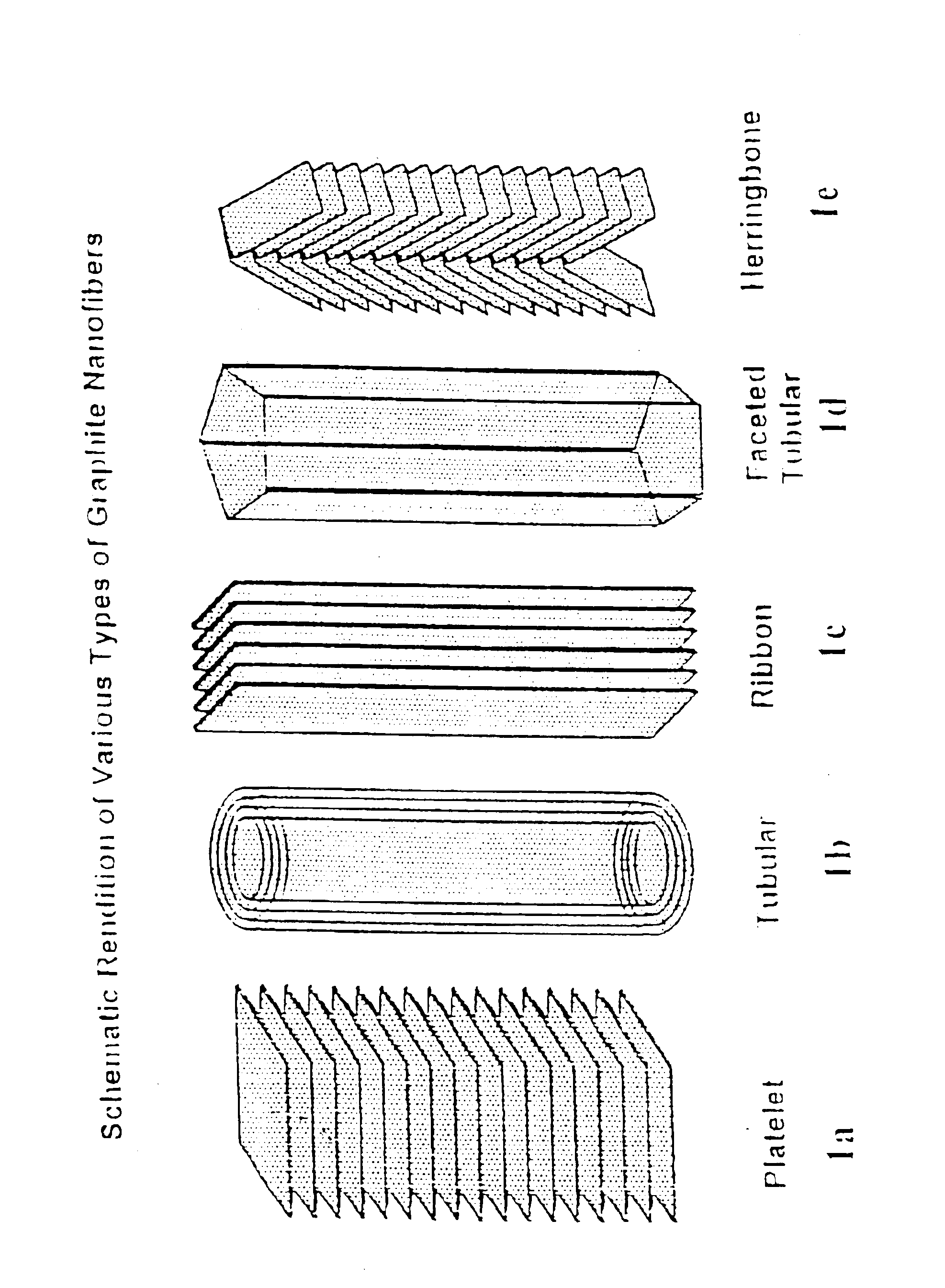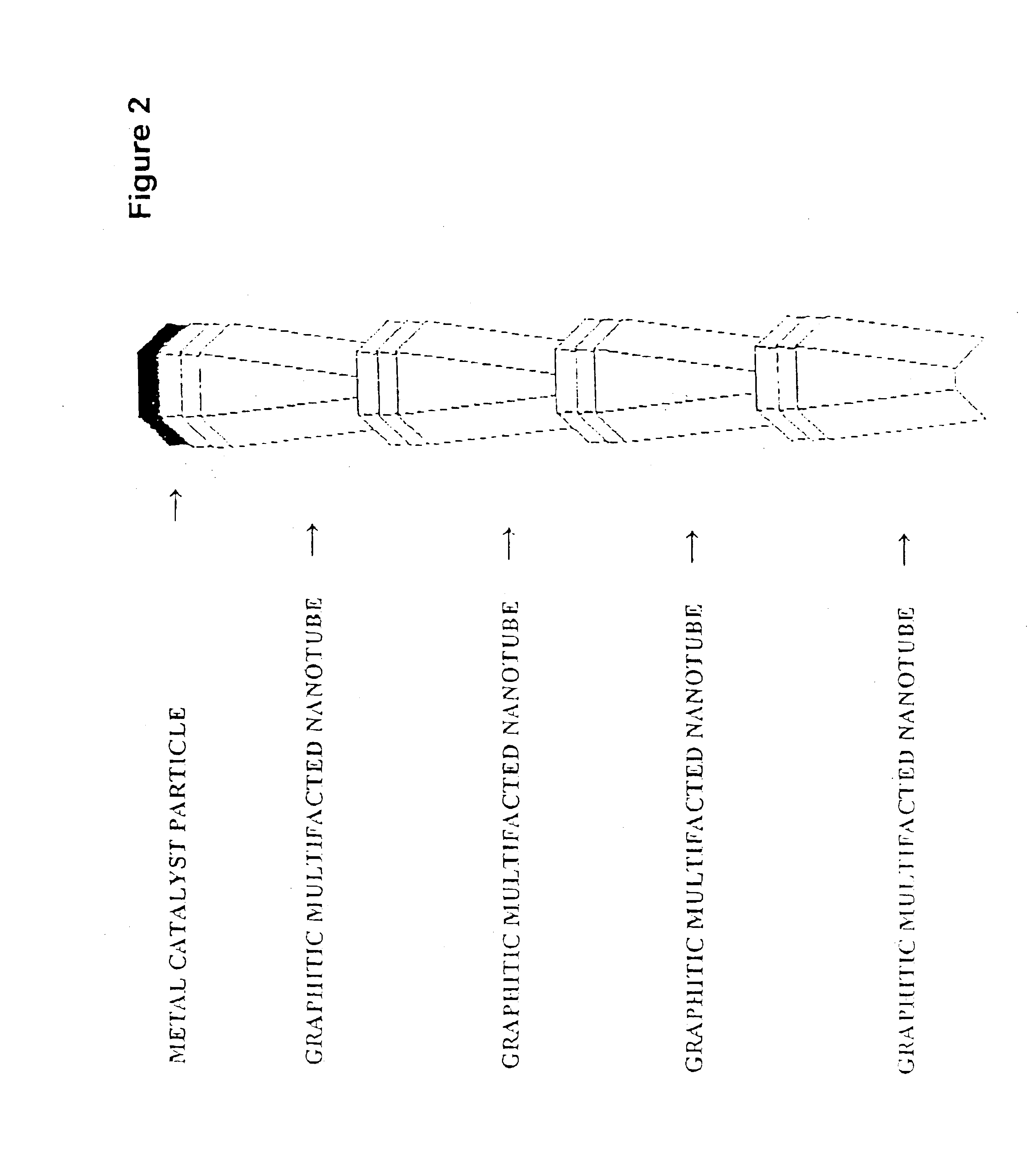Graphite nanocatalysts
- Summary
- Abstract
- Description
- Claims
- Application Information
AI Technical Summary
Problems solved by technology
Method used
Image
Examples
examples
Materials
[0041]The “platelet” graphitic nanofibers (CNF-P) used in these examples were prepared from the decomposition of carbon monoxide / hydrogen mixtures over copper-iron powdered catalysts at 600° C. The “faceted tubular” graphitic nanofibers (GNF-T) were grown from the interaction of Co / MgO with carbon monoxide / hydrogen mixtures at 600° C. The “herring-bone” graphitic nanofibers (GNF-H) were produced from the decomposition of ethylene / hydrogen mixtures over powdered copper-nickel catalysts at 600° C. Prior to use all nanofibers were treated in dilute mineral acid for a period of one week to remove the associated metal catalyst particles. For comparison purposes the behavior of two other types of materials were examined; Vulcan XC-72 carbon from Cabot Corp., Pitch-based carbon fibers from Amoco Performance Products and Darco G-60 active carbon.
[0042]The gases used in these examples were carbon monoxide (99.9%), ethylene (99.95%); hydrogen (99.999%), helium (99.99%) and argon (99....
examples 1
Effect of the CO2 / H2 Ratio on the CO2 to CO Conversion
[0044]In this series of experiments at the completion of the graphitic nanofibers growth step, the C2H4 / H2 (4:1) reactant gas mixture was stopped and the solid carbon product treated at 550° C. in a CO2 / H2 (4:1) mixture for 20 mins and cooled to room temperature. Samples were subsequently reacted in various CO2 / H2 mixtures at 400° C. for periods of up to 22 hours. The percentage conversion of CO2 to CO for the various CO2 / H2 mixtures is presented in Table 1 below. Inspection of these data reveals it is necessary to operate at a CO2 / H2 ratio of 1:2 in order to achieve the highest conversion of CO2 to CO.
[0045]
TABLE 1CO2:H2 (10:20)CO2:H2 (20:20)CO2:H2 (15:30)% CO2% CO2% CO2CO2:H2 (20:40)TimeConver-TimeConver-TimeConver-Time% CO2(hr)sion(hr)sion(hr)sion(hr)Conversion0.7520.00.55.60.515.90.7516.12.019.71.05.73.018.01.7516.78.520.222.020.93.516.3
example 2
Effect of Reaction Temperature on the CO2 to CO Conversion
[0046]In a further set of experiments using a 1.0-gram sample of pretreated graphite nanofibers, the CO2 / H2 ratio was maintained constant at (1:2) and the temperature of the system was sequentially increased from 350 to 475° C. At higher temperatures the gasification of the nanofibers by CO2 starts to occur to form CO and a corresponding loss of the catalyst. The maximum temperature was therefore limited to 475° C. The variation in the percent conversion of CO2 to CO is presented as a function of reaction temperature and time in Table 2 below. From these data it is evident that the optimum catalytic conversion of CO2 to CO is achieved at 475° C. Furthermore, provided that the nanofiber catalyst has been activated by pretreatment in CO2 / H2 (4:1) at 550° C. for a short time then it immediately reaches its optimum catalytic performance at any given reaction condition. This finding indicates that the pretreatment is responsible f...
PUM
| Property | Measurement | Unit |
|---|---|---|
| temperature | aaaaa | aaaaa |
| temperatures | aaaaa | aaaaa |
| temperatures | aaaaa | aaaaa |
Abstract
Description
Claims
Application Information
 Login to View More
Login to View More - R&D
- Intellectual Property
- Life Sciences
- Materials
- Tech Scout
- Unparalleled Data Quality
- Higher Quality Content
- 60% Fewer Hallucinations
Browse by: Latest US Patents, China's latest patents, Technical Efficacy Thesaurus, Application Domain, Technology Topic, Popular Technical Reports.
© 2025 PatSnap. All rights reserved.Legal|Privacy policy|Modern Slavery Act Transparency Statement|Sitemap|About US| Contact US: help@patsnap.com



